2016 October Cisco Official New Released 300-101 Dumps in Lead2pass.com!
100% Free Download! 100% Pass Guaranteed!
In recent years, many people choose to take Cisco 300-101 certification exam which can make you get the Cisco certificate and that is the passport to get a better job and get promotions. How to prepare for Cisco 300-101 exam and get the certificate? Please refer to Cisco 300-101 exam questions and answers on Lead2pass.
Following questions and answers are all new published by Cisco Official Exam Center: http://www.lead2pass.com/300-101.html
QUESTION 41
Lab Simulation 2 – EIGRP Stub
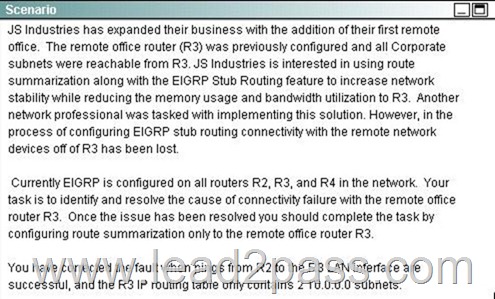
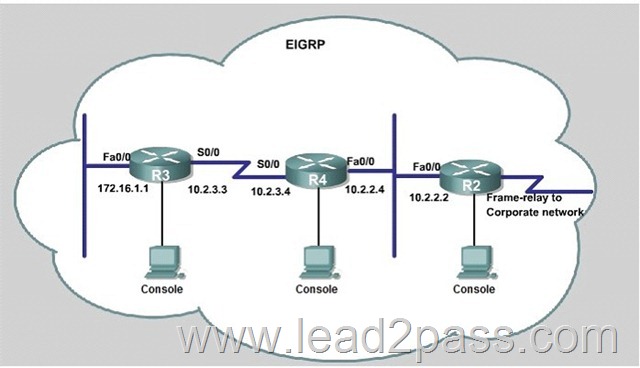
Answer:
First we have to figure out why R3 and R4 can not communicate with each other. Use the “show running-config” command on router R3 
Notice that R3 is configured as a stub receive-only router. The receive-only keyword will restrict the router from sharing any of its routes with any other router in that EIGRP autonomous system. This keyword will also prevent any type of route from being sent.
Therefore we will remove this command and replace it with the eigrp stub command:
R3# configure terminal
R3(config)# router eigrp 123
R3(config-router)# no eigrp stub receive-only
R3(config-router)# eigrp stub
R3(config-router)# end
Now R3 will send updates containing its connected and summary routes to other routers. Notice that the eigrp stub command equals to the eigrp stub connected summary because the connected and summary options are enabled by default.
Next we will configure router R3 so that it has only 2 subnets of 10.0.0.0 network. Use the show ip route command on R3 to view its routing table
R3# show ip route 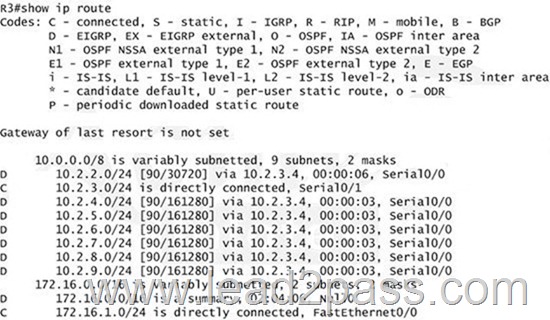
Because we want the routing table of R3 only have 2 subnets so we have to summary sub-networks at the interface which is connected with R3, the s0/0 interface of R4.
There is one interesting thing about the output of the show ip route shown above: the 10.2.3.0/24, which is a directly connected network of R3. We can‘t get rid of it in the routing table no matter what technique we use to summary the networks. Therefore, to make the routing table of R3 has only 2 subnets we have to summary other subnets into one subnet.
In the output if we don’t see the summary line (like 10.0.0.0/8 is a summary…) then we should use the command ip summary-address eigrp 123 10.2.0.0 255.255.0.0 so that all the ping can work well.
In conclusion, we will use the ip summary-address eigrp 123 10.2.0.0 255.255.0.0 at the interface s0/0 of R4 to summary.
R4> enable
R4# configure terminal
R4(config)# interface s0/0
R4(config-if)# ip summary-address eigrp 123 10.2.0.0 255.255.0.0
Now we jump back to R3 and use the show ip route command to verify the effect, the output is shown below: 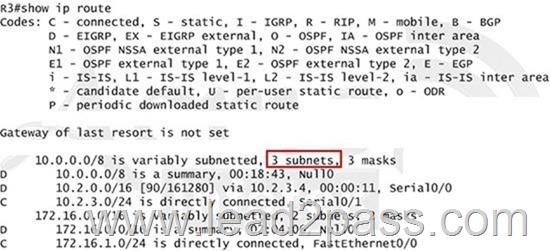
(But please notice that the ip addresses and the subnet masks in your real exam might be different so you might use different ones to solve this question) Just for your information, notice that if you use another network than 10.0.0.0/8 to summary, for example, if you use the command ip summary-address eigrp 123 10.2.0.0 255.255.0.0 you will leave a /16 network in the output of the show ip route command. 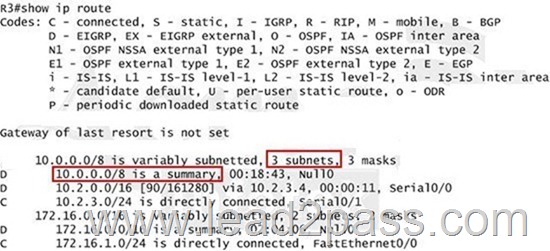
But in your real exam, if you don’t see the line “10.0.0.0/8 is a summary,….Null0” then you can summary using the network 10.2.0.0/16. This summarization is better because all the pings can work well.
Finally don’t forget to use the copy running-config startup-config command on routers R3 and R4 to save the configurations.
R3(config-if)# end
R3# copy run start
R4(config-if)# end
R4# copy run start
QUESTION 42
Lab Simulation 3 – IPv6 OSPF Virtual Link 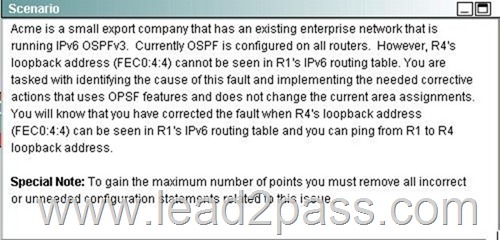
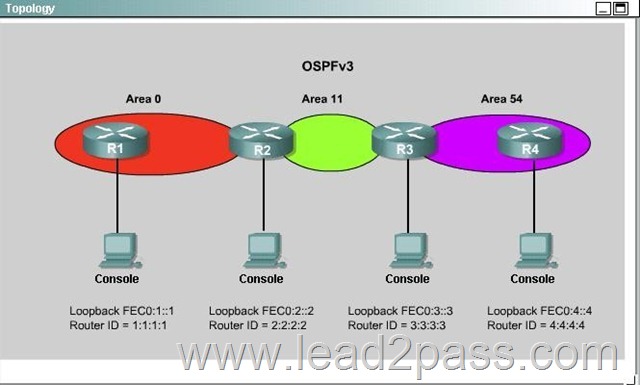
Answer:
To troubleshoot the problem, first issue the show running-config on all of 4 routers.
Pay more attention to the outputs of routers R2 and R3.
The output of the “show running-config” command of R2:
And
The output of the “show running-config” command of R3: 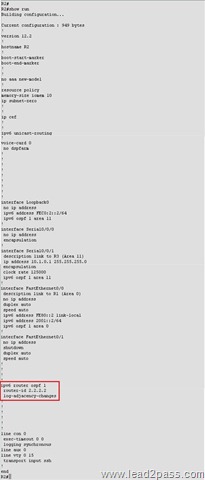
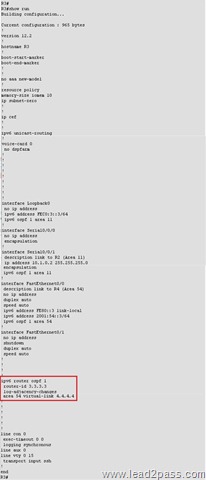
We knew that all areas in an Open Shortest Path First (OSPF) autonomous system must be physically connected to the backbone area (Area 0). In some cases, where this is not possible, we can use a virtual link to connect to the backbone through a non-backbone area. The area through which you configure the virtual link is known as a transit area. In this case, the area 11 will become the transit area. Therefore, routers R2 and R3 must be configured with the area <area id> virtual-link <neighbor router-id> command. + Configure virtual link on R2 (from the first output above, we learned that the OSPF process ID of R2 is 1):
R2> enable
R2# configure terminal
R2(config)# ipv6 router ospf 1
R2(config-rtr)# area 11 virtual-link 3.3.3.3
Save the configuration:
R2(config-rtr)# end
R2# copy running-config startup-config
(Notice that we have to use neighbor router-id 3.3.3.3, not R2’s router-id 2.2.2.2) + Configure virtual link on R3 (from the second output above, we learned that the OSPF process ID of R3 is 1 and we have to disable the wrong configuration of “area 54 virtual-link 4.4.4.4”):
R3> enable
R3# configure terminal
R3(config)# ipv6 router ospf 1
R3(config-rtr)# no area 54 virtual-link 4.4.4.4
R3(config-rtr)# area 11 virtual-link 2.2.2.2
Save the configuration:
R3(config-rtr)# end
R3# copy running-config startup-config
You should check the configuration of R4, too.
R4(config)# ipv6 router ospf 1
R4(config-router)# no area 54 virtual-link 3.3.3.3
R4(config-router)# end
After finishing the configuration don’t forget to ping between R1 and R4 to make sure they work well!
Note: If you want to check the routing information, use the show ipv6 route command ,not “show ip route”.
QUESTION 43
Lab Simulation 4 – Policy Based Routing
You are a network engineer with ROUTE.com, a small IT company. ROUTE.com has two connections to the Internet; one via a frame relay link and one via an EoMPLS link. IT policy requires that all outbound HTTP traffic use the frame relay link when it is available. All other traffic may use either link. No static or default routing is allowed.
Choose and configure the appropriate path selection feature to accomplish this task.
You may use the Test Workstation to generate HTTP traffic to validate your solution. 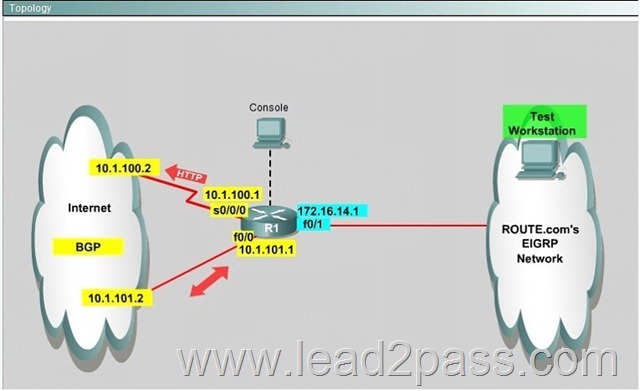
Answer:
(1) First create the access list that catches the HTTP traffic:
R1(config)# access-list 101 permit tcp any any eq www
(2) Configure the route map that sets the next hop address to be ISP1 and permits the rest of the traffic:
R1(config)# route-map pbr permit 10
R1(config-route-map)# match ip address 101
R1(config-route-map)# set ip next-hop 10.1.100.2
R1(config-route-map)# exit
R1(config)# route-map pbr permit 20
(3) Apply the route-map on the interface to the server in the EIGRP Network:
R1(config-route-map)# exit
R1(config)# int fa0/1
R1(config-if)# ip policy route-map pbr
R1(config-if)# exit
R1(config)# exit
QUESTION 44
Lab Simulation – EIGRP OSPF Redistribution
You are a network engineer with ROUTE.com, a small IT company. They have recently merged two organizations and now need to merge their networks as shown in the topology exhibit. One network is using OSPF as its IGP and the other is using EIGRP as its IGP. R4 has been added to the existing OSPF network to provide the interconnect between the OSPF and EIGRP networks. Two links have been added that will provide redundancy.
The network requirements state that you must be able to ping and telnet from loopback 101 on R1 to the OPSF domain test address of 172.16.1.100. All traffic must use the shortest path that provides the greatest bandwidth. The redundant paths from the OSPF network to the EIGRP network must be available in case of a link failure. No static or default routing is allowed in either network.
A previous network engineer has started the merger implementation and has successfully assigned and verified all IP addressing and basic IGP routing. You have been tasked with completing the implementation and ensuring that the network requirements are met. You may not remove or change any of the configuration commands currently on any of the routers. You may add new commands or change default values. 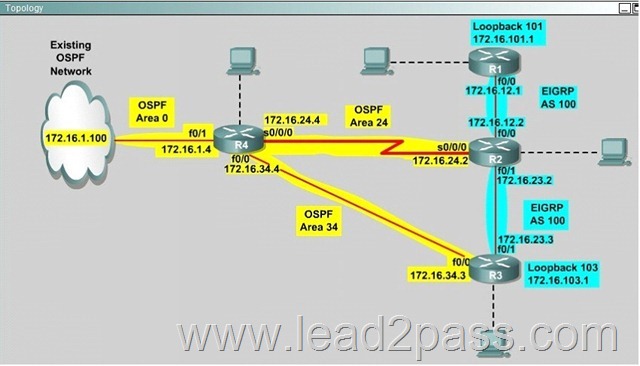
Answer:
R2# show interface s0/0/0
Write down these 5 parameters, notice that we have to divide the Delay by 10 because the metric unit is in tens of microsecond.
For example, we get Bandwidth=1544 Kbit, Delay=20000 us, Reliability=255, Load=1, MTU=1500 bytes then we would redistribute as follows:
R2# config terminal
R2(config)# router ospf 1
R2(config-router)# redistribute eigrp 100 metric-type 1 subnets
R2(config-router)# exit
R2(config-router)# router eigrp 100
R2(config-router)# redistribute ospf 1 metric 1544 2000 255 1 1500
Note: In fact, these parameters are just used for reference and we can use other parameters with no problem.
If the delay is 20000us then we need to divide it by 10, that is 20000 / 10 = 2000)
For R3 we use the show interface fa0/0 to get 5 parameters too
R3# show interface fa0/0
For example we get Bandwidth=10000 Kbit, Delay=1000 us, Reliability=255, Load=1, MTU=1500 bytes
R3# config terminal
R3(config)# router ospf 1
R3(config-router)# redistribute eigrp 100 metric-type 1 subnets
R3(config)# exit
R3(config-router)# router eigrp 100
R3(config-router)# redistribute ospf 1 metric 10000 100 255 1 1500
Finally you should try to “show ip route” to see the 172.16.100.1 network (the network behind R4) in the routing table of R1 and make a ping from R1 to this network.
Note: If the link between R2 and R3 is FastEthernet link, we must put the command below under EIGRP process to make traffic from R1 to go through R3 (R1 -> R2 -> R3 -> R4), which is better than R1 -> R2 -> R4.
R2(config-router)# distance eigrp 90 105
This command sets the Administrative Distance of all EIGRP internal routes to 90 and all EIGRP external routes to 105, which is smaller than the Administrative Distance of OSPF (110) -> the link between R2 & R3 will be preferred to the serial link between R2 & R4.
Note: The actual OPSF and EIGRP process numbers may change in the actual exam so be sure to use the actual correct values, but the overall solution is the same.
QUESTION 45
You have been asked to evaluate how EIGRP is functioning in a customer network. 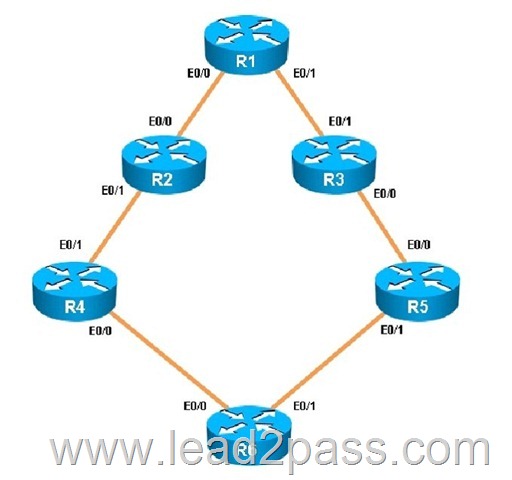
Traffic from R1 to R6’s Loopback address is load shared between R1-R2-R4-R6 and R1-R3-R5-R6 paths. What is the ratio of traffic over each path?
A. 1:1
B. 1:5
C. 6:8
D. 19:80
Answer: D
Explanation:
First, find the IP address of the loopback0 interface on R6:
We see that it is 150.1.6.6, so we issue the “show ip route 150.1.6.6” command from R1 and see this:
Notice the “traffic share count” shows 19 for the first path, and 80 for the second path.
QUESTION 46
You have been asked to evaluate how EIGRP is functioning in a customer network. 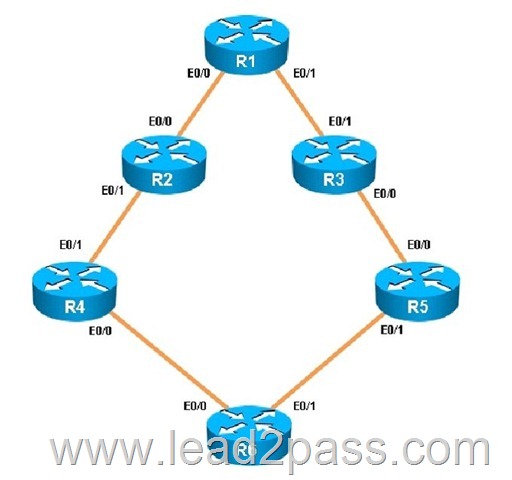
What type of route filtering is occurring on R6
A. Distribute-list using an ACL
B. Distribute-list using a prefix-list
C. Distribute-list using a route-map
D. An ACL using a distance of 255
Answer: A
Explanation:
The configuration on R6 is as follows:
This is a standard distribute list using access list number 1.
QUESTION 47
You have been asked to evaluate how EIGRP is functioning in a customer network. 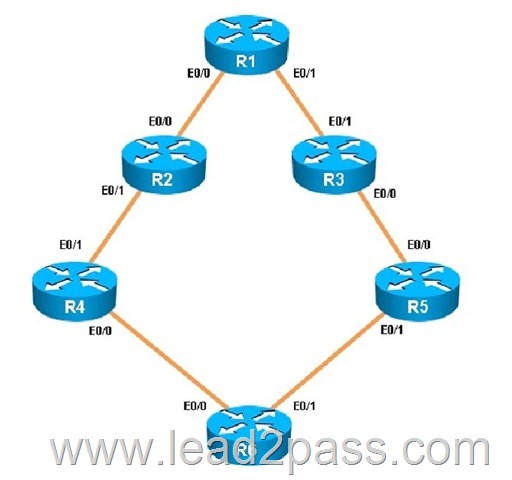
Which key chain is being used for authentication of EIGRP adjacency between R4 and R2?
A. CISCO
B. EIGRP
C. key
D. MD5
Answer: A
Explanation:
R4 and R2 configs are as shown below:
Clearly we see the actual key chain is named CISCO.
QUESTION 48
You have been asked to evaluate how EIGRP is functioning in a customer network. 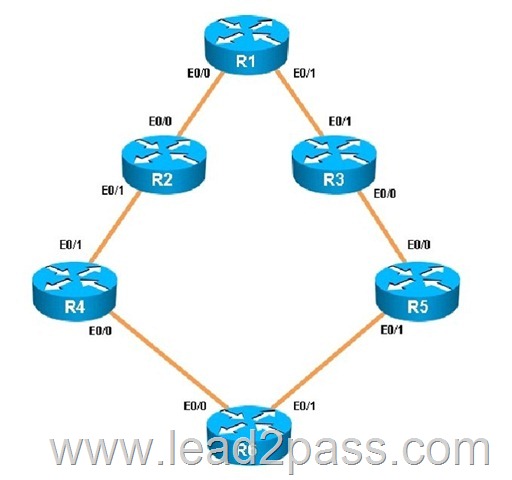
What is the advertised distance for the 192.168.46.0 network on R1?
A. 333056
B. 1938688
C. 1810944
D. 307456
Answer: C
Explanation:
R1’s routing table is as follows
The numbers after the route specify the administrative distance of the route (90 for EIGRP) and the distance metric of that particular route, which is shows as 1810944 for the 192.168.46.0 route.
QUESTION 49
You have been asked to evaluate how EIGRP is functioning in a customer network. 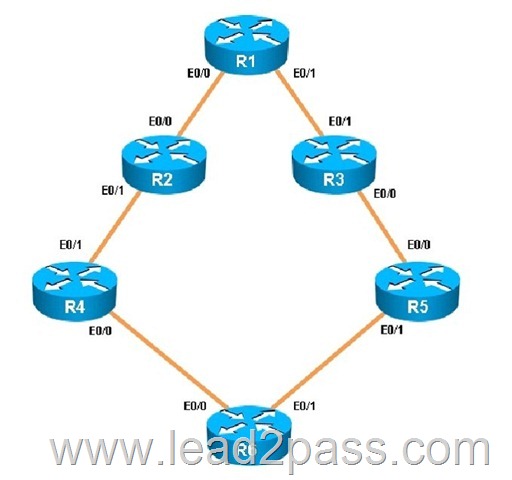
What percent of R1’s interfaces bandwidth is EIGRP allowed to use?
A. 10
B. 20
C. 30
D. 40
Answer: B
Explanation:
The relevant configuration of R1 is shown below:
ip bandwidth-percent eigrp 1 20
1 = the EIGRP AS
20 = 20% of the bandwidth
QUESTION 50
Scenario:
You have been asked to evaluate an OSPF network setup in a test lab and to answer questions a customer has about its operation. The customer has disabled your access to the show running-config command. 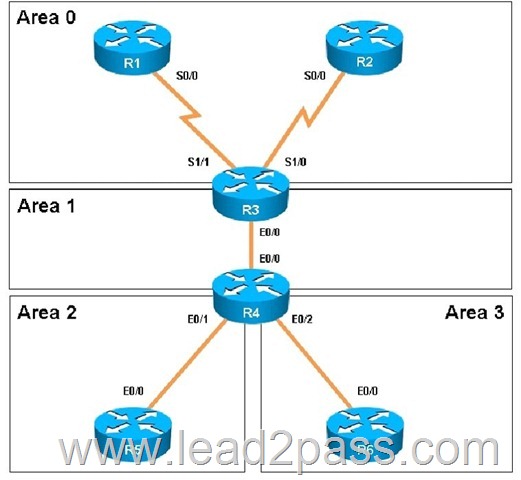
How old is the Type 4 LSA from Router 3 for area 1 on the router R5 based on the output you have examined?
A. 1858
B. 1601
C. 600
D. 1569
Answer: A
Explanation:
Part of the “show ip ospf topology” command on R5 shows this:
The Link ID of R3 (3.3.3.3) shows the age is 1858.
Lead2pass is a good website that provides all candidates with the latest IT certification exam materials. Lead2pass will provide you with the exam questions and verified answers that reflect the actual exam. The Cisco 300-101 exam dumps are developed by experienced IT professionals. 99.9% of hit rate. Guarantee you success in your 300-101 exam with our exam materials.
300-101 new questions on Google Drive: https://drive.google.com/open?id=0B3Syig5i8gpDeXZ6R3kxS05wV0E
2016 Cisco 300-101 exam dumps (All 183 Q&As) from Lead2pass:
http://www.lead2pass.com/300-101.html [100% Exam Pass Guaranteed]